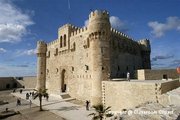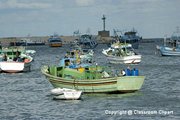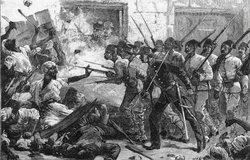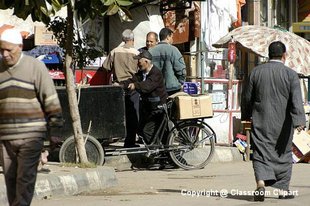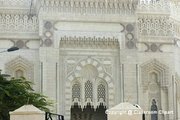Alexandria
|
|
Located on the Mediterranean Sea coast, Alexandria (in Arabic, الإسكندرية, transliterated al-ʼIskandariyyah) is the chief seaport in Egypt, and that country's second largest city, and the capital of the Al Iskandariyah governate. It is located at Template:Coor dm, 208 km (129 miles) northwest of Cairo. The Canopic mouth of the Nile (now dry) was 19 km (12 miles) east, near the ancient city of Canopus. It has a population of approximately 3,341,000.
It was named after its founder, Alexander the Great, and as the seat of the Ptolemaic rulers of Egypt quickly became one of the greatest cities of the Hellenistic world — second only to Rome in size and wealth throughout much of antiquity. However, upon the founding of Cairo by Egypt's mediæval Islamic rulers its status as the country's capital was ended, and it fell into a long decline, which by the late Ottoman period had seen it reduced to little more than a small fishing village.
| Contents |
History
The history of Alexandria covers four periods:
- The Ptolemaic era which starts with the founding of the city and ends with the arrival of the Romans (blue).
- The Roman era from 80 BC until the arrival of the Arabs in 641 (green).
- The Arab city from 641 until 1798 when Napoleon arrived (yellow).
- The modern city from 1798 (red).
Foundation
Alexandria was founded by Alexander the Great in or around 334 BC (the exact date is disputed). Alexander's chief architect for the project was Deinocrates of Rhodes. Ancient accounts are extremely numerous and varied, and much influenced by subsequent developments. One of the more sober descriptions, given by the historian Arrian, tells how Alexander undertook to lay out the city's general plan, but lacking chalk or other means, resorted to sketching it out with grain. Alexander's seers, and in particular Aristander of Telmessus, interpreted this as an omen that the city would prosper, particularly in grain. Other authors make the omen not the grain itself, but the arrival of flocks of birds to eat it. In any case, the story explains Alexandria's role as the shipping-point for Egyptian grain, which fed the Hellenistic and Roman world.
A number of the more fantastic foundation myths are found in the Alexander Romance, and were picked up by mediæval Arab historians. The 14th century Arab historian Ibn Khaldun ridiculed one where sea-monsters prevent the foundation, but are thwarted when Alexander descends in a glass box, and armed with exact knowledge of their appearance, erects metal effigies on the beach which succeed in frightening the monsters away.
Alexandria was intended to supersede Naucratis as a Greek centre in Egypt, and to be the link between Greece and the rich Nile Valley. If such a city was to be on the Egyptian coast, there was only one possible site, behind the screen of the Pharos island and removed from the silt thrown out by Nile mouths. An Egyptian townlet, Rhacotis, already stood on the shore and was a resort of fishermen and pirates. Behind it there were five native villages scattered along the strip between Lake Mareotis and the sea, according to a history of Alexander attributed to the author known as pseudo-Callisthenes.
A few months after the foundation, Alexander left Egypt for the East and never returned to his city. His general, Ptolemy (later Ptolemy I of Egypt) succeeded in bringing Alexander's body to Alexandria, where it became a famous tourist destination for ancient travellers.
After Alexander departed, his viceroy, Cleomenes, continued the creation of Alexandria. The Heptastadion, however, and the mainland quarters seem to have been mainly Ptolemaic work. Inheriting the trade of ruined Tyre and becoming the centre of the new commerce between Europe and the Arabian and Indian East, the city grew in less than a century to be larger than Carthage; and for some centuries more it was second only to Rome. Nominally a free Greek city, Alexandria retained its senate to Roman times; and indeed the judicial functions of that body were restored by Septimius Severus, after temporary abolition by Augustus.
It was not only a center of Hellenism, but was also the greatest Jewish city in the world. There the Septuagint was produced. The early Ptolemies kept it in order and fostered the development of its museum into the leading Greek university but they were careful to maintain the distinction of its population into three nations, "Greek", Jew and Egyptian. One of the earliest inhabitants was the geometer and number-theorist Euclid. From this division arose much of the later turbulence which began to manifest itself under Ptolemy Philopater, who reigned 221–204 BC.
In ancient times, Alexandria was known for its lighthouse (one of the Seven Wonders of the World) and its library (the largest in the world). Ongoing maritime archaeology in the harbor of Alexandria, begun in 1994, is revealing details of the Alexandria of the Ptolemaic dynasty.
Roman jurisdiction
The city passed formally under Roman jurisdiction in 80 BC, according to the will of Ptolemy Alexander: but it had been under Roman influence for more than a hundred years previously. Julius Caesar dallied with Cleopatra in Alexandria in 47 BC and was mobbed by the rabble; his example was followed by Marc Antony, for whose favor the city paid dear to Octavian, who placed over it a prefect from the imperial household.
Alexandria seems from this time to have regained its old prosperity, commanding, as it did, an important granary of Rome; this fact, doubtless, was one of the chief reasons which induced Augustus to place it directly under imperial power. In AD 215 the emperor Caracalla visited the city; and, for some insulting satires that the inhabitants had directed at him, he abruptly commanded his troops to put to death all youths capable of bearing arms. This brutal order seems to have been carried out even beyond the letter, for a general massacre was the result.
Even as its main historical importance had formerly sprung from pagan learning, so now it acquired fresh importance as a centre of Christian theology and church government. There Arianism was formulated and there Athanasius, the great opponent of both Arianism and pagan reaction, triumphed over both, establishing the Patriarch of Alexandria as a major influence in Christianity for the next two centuries.
As native influences, however, began to reassert themselves in the Nile valley, Alexandria gradually became an alien city, more and more detached from Egypt; and, losing much of its commerce as the peace of the empire broke up during the 3rd century AD, it declined fast in population and splendour.
In the late 4th century, persecution of pagans by Christians had reached new levels of intensity. Temples and statues were destroyed throughout the Roman empire, pagan rituals forbidden under punishment of death, and libraries closed. In 391, Emperor Theodosius ordered the destruction of all pagan temples, and the Patriarch Theophilus, , complied with this request. It is possible that the great Library of Alexandria was destroyed about this time. See: Destruction of the pagan temples by Theophilus.
The Brucheum and Jewish quarters were desolate in the 5th century, and the central monuments, the Soma and Museum, fallen to ruin. On the mainland, life seems to have centred in the vicinity of the Serapeum and Caesareum; both become Christian churches. The Pharos and Heptastadium quarters remained populous and intact.
In 616 it was taken by Khosrau II, king of Persia. Although the Byzantine Emperor Heraclius recovered it a few years later, in 640 the Arabians, under the general Amr ibn al-As, captured it for good after a siege that lasted fourteen months. The city received no aid from Constantinople during that time; Heraclius was dead and the new Emperor Constantine III was barely twelve years old. Notwithstanding the losses that the city had sustained, Amr was able to write to his master, the caliph Omar, that he had taken a city containing "4,000 palaces, 4,000 baths, 12,000 dealers in fresh oil, 12,000 gardeners, 40,000 Jews who pay tribute, 400 theatres or places of amusement."
After Amr
Shortly after its capture, Alexandria again fell into the hands of the Greeks, who took advantage of Amr's absence with the greater portion of his army. On hearing what had happened, however, Amr returned, and quickly regained possession of the city. About the year 646, Amr was deprived of his government by the caliph Uthman ibn Affan. Amr was greatly beloved by the Egyptians; they threatened such a revolt over this that the Greek emperor was determined to reduce Alexandria.
The attempt proved successful. The caliph, perceiving his mistake, immediately restored Amr, who, on his arrival in Egypt, drove the Greeks within the walls of Alexandria, but was only able to capture the city after a most obstinate resistance by the defenders. This so exasperated him that he completely demolished its fortifications, although he seems to have spared the lives of the inhabitants as far as lay in his power.
Alexandria now rapidly declined in importance. The building of Cairo in 969, and, above all, the discovery of the route to the East by the Cape of Good Hope in 1498, nearly ruined its commerce; the canal, which supplied it with Nile water, became blocked; and although it remained a principal Egyptian port, at which most European visitors in the Mamluk and Ottoman periods landed, we hear little of it until about the beginning of the 19th century.
Alexandria figured prominently in the military operations of Napol鯮's Egyptian expedition of 1798. The French troops stormed the city on July 2 1798, and it remained in their hands until the arrival of the British expedition of 1801. The battle of Alexandria, fought on March 21 that year between the French and the British, took place near the ruins of Nicopolis, on the narrow spit of land between the sea and Lake Abukir.
The 1800s
During the anarchy which accompanied Ottoman rule in Egypt from first to last, Alexandria sank to a small town of about 4,000 inhabitants, and it owed its modern rennaissance solely to Mehemet Ali, who wanted a deep port and naval station for his viceregal domain. He restored its water communication with the Nile by making the Mahmudiya canal, finished in 1820; and he established at Ras et-Tin his favorite residence. The old Eunostus harbour became the port, and a flourishing city arose on the Pharos island and the Heptastadion district, with outlying suburbs and villa residences along the coast eastwards and the Mareotic shore.
Being the starting-point of the "overland route" to India, and the residence of the chief foreign consuls, it quickly acquired a European character and attracted not only French residents, but great numbers of Greeks, Jews and Syrians. There most of the negotiations between the powers and Mehemet Ali were conducted; from there started the Egyptian naval expeditions to Crete, the Morea and Syria; and thither sailed the betrayed Ottoman fleet in 1839. It was twice threatened by hostile fleets, the Greek in 1827 and the combined British, French and Russian squadrons in 1828.
The latter withdrew on the viceroy's promise that Ibrahim should evacuate the Morea. The fortifications were strengthened in 1841, and remained in an antiquated condition until 1882, when they were renovated by Arabi Pasha. Alexandria was connected with Cairo by railway in 1856.
Much favored by the earlier viceroys of Mehemet Ali's house, and removed from the Mameluke troubles, Alexandria was the real capital of Egypt until Said Pasha died there in 1863 and Ismail Pasha came into power. Though this prince continued to develop the city, giving it a municipality in 1861 and new harbour works in 1871–1878, he developed Cairo still more; and the center of gravity definitely shifted to the inland capital.
Bombardment of 1882
Fate, however, again brought Alexandria to the front. After a mutiny of soldiers there in 1881, the town was greatly excited by the arrival of an Anglo-French fleet in May 1882, and on June 11 a terrible riot and massacre took place, resulting in the death of four hundred Europeans.
Since satisfaction was not given for this and the forts were being strengthened at the instigation of Arabi Pasha, the war minister, the British admiral, Sir Frederick Beauchamp Seymour (afterwards Lord Alcester), sent an ultimatum on July 10 and opened fire on the forts the next day. They were demolished, but as no troops were landed immediately a fresh riot and massacre ensued.
As Arabi did not submit, a British military expedition landed at Alexandria on August 10, following which the British engaged in the occupation of the whole country.
Under British control
Alexandria has greatly expanded since then. As the British consular report for 1904 says, "Building … for residential and other purposes proceeds with almost feverish rapidity. The cost of living has doubled and the price of land has risen enormously."
More Greeks continued to settle the city, establishing financial and cultural centres. The homoerotic Greek poet Constantine Cavafy was born and lived here.
British occupied Alexandria developed into a major Royal Navy base, with the strategic Suez Canal to the east. During Second World War and the North Africa Campaign of 1940–1943 The decisive Battles of El Alamein were fought to its West.
The Egyptian military coup of 1952 saw the destruction of the Egyptian monarchy and the British protectorate status. Colonel Nasser took power and the Anglo-Egyptian Treaty of 1954 made provision for the withdrawal of British troops. The numbers of the city's foreign population dwindled ever since. A small Greek community, however, remains to date.
The film Ice Cold in Alex would later be set here.
Geography
Layout of the ancient city
The Greek Alexandria was divided into three regions:
- The Jews' quarter, forming the northeast portion of the city;
- Rhacotis, on the west, occupied chiefly by Egyptians;
- Brucheum, the Royal or Greek quarter, forming the most magnificent portion of the city.
In Roman times Brucheum was enlarged by the addition of an official quarter, making up four regions in all. The city was laid out as a grid of parallel streets, each of which had an attendant subterranean canal.
Two main streets, lined with colonnades and said to have been each about 60 metres (200 feet) wide, intersected in the centre of the city, close to the point where rose the Sema (or Soma) of Alexander (his Mausoleum). This point is very near the present mosque of Nebi Daniel; and the line of the great east–west "Canopic" street only slightly diverged from that of the modern Boulevard de Rosette. Traces of its pavement and canal have been found near the Rosetta Gate, but better remains of streets and canals were exposed in 1899 by German excavators outside the east fortifications, which lie well within the area of the ancient city.
Alexandria consisted originally of little more than the island of Pharos, which was joined to the mainland by a mole nearly a mile long and called the Heptastadion ("seven stadia" — a stadium was a Greek unit of length measuring approximately 200m). The end of this abutted on the land at the head of the present Grand Square, where rose the "Moon Gate." All that now lies between that point and the modern Ras et-Tin quarter is built on the silt which gradually widened and obliterated this mole. The Ras et-Tin quarter represents all that is left of the island of Pharos, the site of the actual lighthouse having been weathered away by the sea. On the east of the mole was the Great Harbour, now an open bay; on the west lay the port of Eunostos, with its inner basin Kibotos, now vastly enlarged to form the modern harbour.
In Strabo's time, (latter half of 1st century BC) the principal buildings were as follows, enumerated as they were to be seen from a ship entering the Great Harbour.
- The Royal Palaces, filling the northeast angle of the town and occupying the promontory of Lochias, which shut in the Great Harbour on the east. Lochias (the modern Pharillon) has almost entirely disappeared into the sea, together with the palaces, the "Private Port" and the island of Antirrhodus. There has been a land subsidence here, as throughout the northeast coast of Africa.
- The Great Theatre, on the modern Hospital Hill near the Ramleh station. This was used by Caesar as a fortress, where he stood a siege from the city mob after the battle of Pharsalus
- The Poseideion, or Temple of the Sea God, close to the Theatre
- The Timonium built by Mark Antony
- The Emporium (Exchange)
- The Apostases (Magazines)
- The Navalia (Docks), lying west of the Timonium, along the sea-front as far as the mole
- Behind the Emporium rose the Great Caesareum, by which stood the two great obelisks, each later known as "Cleopatra's Needle," and now removed to New York City and London. This temple became in time the Patriarchal Church, some remains of which have been discovered; but the actual Caesareum, so far as not eroded by the waves, lies under the houses lining the new sea-wall.
- The Gymnasium and the Palaestra are both inland, near the Boulevard de Rosette in the eastern half of the town; sites unknown.
- The Temple of Saturn; site unknown.
- The Mausolea of Alexander (Soma) and the Ptolemies in one ring-fence, near the point of intersection of the two main streets
- The Musaeum with its famous Library and theatre in the same region; site unknown.
- The Serapeum, the most famous of all Alexandrian temples. Strabo tells us that this stood in the west of the city; and recent discoveries go far to place it near "Pompey's Pillar" which, however, was an independent monument erected to commemorate Diocletian's siege of the city.
We know the names of a few other public buildings on the mainland, but nothing as to their position.
On the eastern point of the Pharos island stood the Great Lighthouse, one of the "Seven Wonders," reputed to be 122 meters (400 feet) high. The first Ptolemy began it, and the second completed it, at a total cost of 800 talents. It took 12 years to construct. It is the prototype of all lighthouses in the world. The light was produced by a furnace at the top. It was built mostly with solid blocks of limestone. The Pharos lighthouse was destroyed by an earthquake.
A temple of Hephaestus also stood on Pharos at the head of the mole. In the Augustan age the population of Alexandria was estimated at 300,000 free folk, in addition to an immense number of slaves.
The modern city
Nov15840.JPG
The city is built on the strip of land which separates the Mediterranean from Lake Mareotis (Mariout), and on a T-shaped peninsula which forms harbors east and west. The stem of the T was originally a mole (breakwater) leading to the island of Pharos which formed the cross-piece. In the course of centuries this mole has been silted up and is now an isthmus half a mile wide. On it a part of the modern city is built. The cape at the western end of the peninsula is Ras et-Tin (Cape of Figs); the eastern cape is known as Pharos or Kait Bey. South of the town — between it and Lake Mareotis — runs the Mahmudiya canal, which enters the western harbour by a series of locks.
Egypt.Alexandria.Tram.01.jpg
The Place Mehemet Ali, usually called the Grand Square, is an oblong open space, tree-lined, in the center of which there is an equestrian statue of the ruler after whom it is named. The square is faced with handsome buildings mainly in the Italian style. The most important are the law courts, exchange, Ottoman bank, English church and the Abbas Hilmi theatre.
Tram_in_Alex.jpg
On the Ras et-Tin promontory, overlooking the harbour, is the khedivial yacht club (built 1903) and the palace, also called Ras et-Tin, built by Mehemet Ali. In the district between the Grand Square and the western harbour, one of the poorest quarters of the city, is an open space with Fort Caffareli or Napoleon in the center.
A major new library and cultural complex, the Bibliotheca Alexandrina, was recently built with the help of the United Nations. The original library contained authentic books from the time of Cleopatra but they were later burned when the library was destroyed.
The predominant languages spoken, besides the Arabic of the natives, are Greek, French, English and Italian.
Alexandria is served by a network of trams traveling east and west roughly parallel to the Corniche, or sea wall.
Ancient remains
Very little of the ancient city has survived into the present day. Much of the royal and civic quarter has sunk beneath the harbour due to earthquake subsidence, and much of the rest has been built upon in modern times. "Pompey's Pillar" is the most well-known ancient monument still standing. It is located on Alexandria's ancient acropolis — a modest hill located adjacent to the city's Arab cemetery — and was originally part of a temple colonnade. Including its pedestal it is 30m (99 feet) high; the shaft is of polished red granite, roughly three meters in diameter at the base, tapering to two and a half meters at the top. It has, however, nothing to do with Pompey, having been erected in AD 293 for Diocletian. Beneath the acropolis itself are the subterranean remains of the Serapeum, where the mysteries of the god Serapis were enacted, and whose carved wall niches are believed to have provided overflow storage space for the ancient Library.
Alexandria's catacombs, known as "Kom al Sukkfa" are a short distance southwest of the pillar, consist of a multi-level labyrinth, reached via a large spiral staircase, and featuring dozens of chambers adorned with sculpted pillars, statues, and other syncretic Romano-Egyptian religious symbols, burial niches and sarcophagi, as well as a large Roman-style banquet room, where memorial meals were conducted by relatives of the deceased.
The most extensive ancient excavation currently being conducted in Alexandria is known as "Kom al Dikka", and it has revealed the ancient city's well-preserved theatre, and the remains of its Roman-era baths.
Antiquities
Persistent efforts have been made to explore the antiquities of Alexandria. Encouragement and help have been given by the local Archaeological Society, and by many individuals, notably Greeks justly proud of a city which is one of the glories of their national history.
The past and present directors of the museum have been enabled from time to time to carry out systematic excavations when opportunity offered; Mr DG Hogarth made tentative researches on behalf of the Egypt Exploration Fund and the Society for the Promotion of Hellenic Studies in 1895; and a German expedition worked for two years (1898–1899). But two difficulties face the would-be excavator in Alexandria.
First, since the great and growing modern city stands right over the ancient one, it is almost impossible to find any considerable space in which to dig, except at enormous cost. Second, the general subsidence of the coast has sunk the lower-lying parts of the ancient town under water.
Unfortunately the spaces still most open are the low grounds to northeast and southwest, where it is practically impossible to get below the Roman strata.
The most important results were those achieved by Dr G Botti, late director of the museum, in the neighbourhood of "Pompey's Pillar," where there is a good deal of open ground. Here substructures of a large building or group of buildings have been exposed, which are perhaps part of the Serapeum. Hard by immense catacombs and columbaria have been opened which may have been appendages of the temple. These contain one very remarkable vault with curious painted reliefs, now lighted by electricity and shown to visitors.
The objects found in these researches are in the museum, the most notable being a great basalt bull, probably once an object of cult in the Serapeum. Other catacombs and tombs have been opened in Kore es-Shugafa Hadra (Roman) and Ras et-Tin (painted).
The Germans found remains of a Ptolemaic colonnade and streets in the north-east of the city, but little else. Mr Hogarth explored part of an immense brick structure under the mound of Kom ed-Dik, which may have been part of the Paneum, the Mausolea or a Roman fortress.
The making of the new foreshore led to the dredging up of remains of the Patriarchal Church; and the foundations of modern buildings are seldom laid without some objects of antiquity being discovered. The wealth underground is doubtless immense; but, despite all efforts, there is not much for antiquarians to see in Alexandria outside the museum and the neighbourhood of "Pompey's Pillar." The native tomb-robbers, well-sinkers, dredgers and the like, however, come upon valuable objects from time to time, which find their way into private collections.
Ancient Egypt Clipart and Pictures
- Ancient Egypt Architecture (http://classroomclipart.com/cgi-bin/kids/imageFolio.cgi?direct=History/Ancient_Civilizations/Ancient_Egypt/Architecture)
- Ancient Egypt Art (http://classroomclipart.com/cgi-bin/kids/imageFolio.cgi?direct=History/Ancient_Civilizations/Ancient_Egypt/Art)
- Ancient Egypt Clipart (http://classroomclipart.com/cgi-bin/kids/imageFolio.cgi?direct=History/Ancient_Civilizations/Ancient_Egypt/Clipart)
- Ancient Egypt Clothing (http://classroomclipart.com/cgi-bin/kids/imageFolio.cgi?direct=History/Ancient_Civilizations/Ancient_Egypt/Clothing)
- Ancient Egypt Architecture (http://classroomclipart.com/cgi-bin/kids/imageFolio.cgi?direct=History/Ancient_Civilizations/Ancient_Egypt/Commerce)
- Ancient Egypt Daily Life (http://classroomclipart.com/cgi-bin/kids/imageFolio.cgi?direct=History/Ancient_Civilizations/Ancient_Egypt/Daily_Life)
- Ancient Egypt Games and Toys (http://classroomclipart.com/cgi-bin/kids/imageFolio.cgi?direct=History/Ancient_Civilizations/Ancient_Egypt/Games_and_Toys)
- Ancient Egypt Hieroglyphs (http://classroomclipart.com/cgi-bin/kids/imageFolio.cgi?direct=History/Ancient_Civilizations/Ancient_Egypt/Hieroglyphs)
- Ancient Egypt People (http://classroomclipart.com/cgi-bin/kids/imageFolio.cgi?direct=History/Ancient_Civilizations/Ancient_Egypt/Historical_People)
- Ancient Egypt Illustrations (http://classroomclipart.com/cgi-bin/kids/imageFolio.cgi?direct=History/Ancient_Civilizations/Ancient_Egypt/Illustrations)
- Ancient Egypt Mummies (http://classroomclipart.com/cgi-bin/kids/imageFolio.cgi?direct=History/Ancient_Civilizations/Ancient_Egypt/Mummies)
- Ancient Egypt Musical Instruments (http://classroomclipart.com/cgi-bin/kids/imageFolio.cgi?direct=History/Ancient_Civilizations/Ancient_Egypt/Musical_Instruments)
- Ancient Egypt Pyramids (http://classroomclipart.com/cgi-bin/kids/imageFolio.cgi?direct=History/Ancient_Civilizations/Ancient_Egypt/Pyramids)
- Ancient Egypt Religion (http://classroomclipart.com/cgi-bin/kids/imageFolio.cgi?direct=History/Ancient_Civilizations/Ancient_Egypt/Religion)
- Ancient Egypt Statues (http://classroomclipart.com/cgi-bin/kids/imageFolio.cgi?direct=History/Ancient_Civilizations/Ancient_Egypt/Statues)
- Ancient Egypt Temples (http://classroomclipart.com/cgi-bin/kids/imageFolio.cgi?direct=History/Ancient_Civilizations/Ancient_Egypt/Temples)
- Ancient Egypt Transportation (http://classroomclipart.com/cgi-bin/kids/imageFolio.cgi?direct=History/Ancient_Civilizations/Ancient_Egypt/Transportation)
- Ancient War and Armies (http://classroomclipart.com/cgi-bin/kids/imageFolio.cgi?direct=History/Ancient_Civilizations/Ancient_Egypt/War_and_Armies)
External links
- http://ce.eng.usf.edu/pharos/Alexandria/index.html
- Seven Wonders of the world: Lighthouse of Alexandria (http://www.sevenwondersworld.com/wonders_of_world_lighthouse_alexandria.html)
- Mostafa el-Abbadi on the pivotal place of Alexandria in Greek and Roman era trade networks (http://www.unesco.org/csi/pub/source/alex5.htm)

